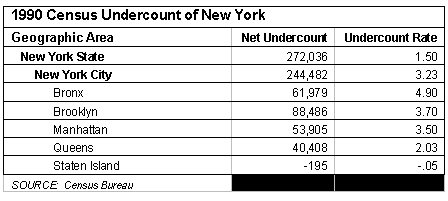
As you probably already know, the next decennial census will take place in 2000. An accurate census is critical because the data is used to inform planning, monitor compliance with federal statutes, reapportion legislative districts, and perhaps most importantly, allocate billions in federal revenue. Elected leaders and community advocates in New York City have already begun to mobilize for a more accurate count than the 1990 census. Actions have included holding Council hearings about the impact of Census 2000 on immigrants and pursuing litigation in support of statistical sampling.
The 1990 census missed 8.4 million people and double-counted 4.4 million others nationwide, according to the Census Bureau's Post Enumeration Survey. It conservatively estimates that 244,582 people were missed in New York City (see the figure below for a geographic breakdown). The city had an undercount rate of 3.2 percent, almost twice the national average of 1.8 percent. The undercount rate is the percentage of people missed in the true population.
Census data is used to allocate $180 billion dollars to over one hundred federal programs. New York City possesses many characteristics that the Census Bureau describes as barriers to counting. These include high concentrations of people who:
Renters are more likely to be missed than homeowners, urban (and rural) dwellers more likely than suburban residents, and people of color more likely than whites. In fact, the 1990 census missed one in ten African Americans, one in twenty Latinos and one in thirty children - all significant populations in New York City.
While the loss in revenues is difficult to quantify, the city's undercount surely costs it millions in federal revenue for housing, education, social services, transportation and more.
Demographic breakdowns of the undercount also suggest that the type of revenue foregone shortchanged communities that might have benefited most from these funds. For example, the U.S. Dept. of Education uses census data to allocate Title I funds to improve the education of economically disadvantaged children, one of the groups affected by undercounting. The 1990 Census failed to count 113,486 children in New York State of which 66,579 were in New York City. According to the Children's Defense Fund, this many children in the state would fill 99 schools requiring 4,380 teachers to staff them. Given the boom in school enrollment and the city's difficulty in maintaining adequate per pupil spending, the city could benefit greatly from a more accurate count of its children. (For more on this issue, see the IBO analysis of Board of Education funding trends, January 1997.)
